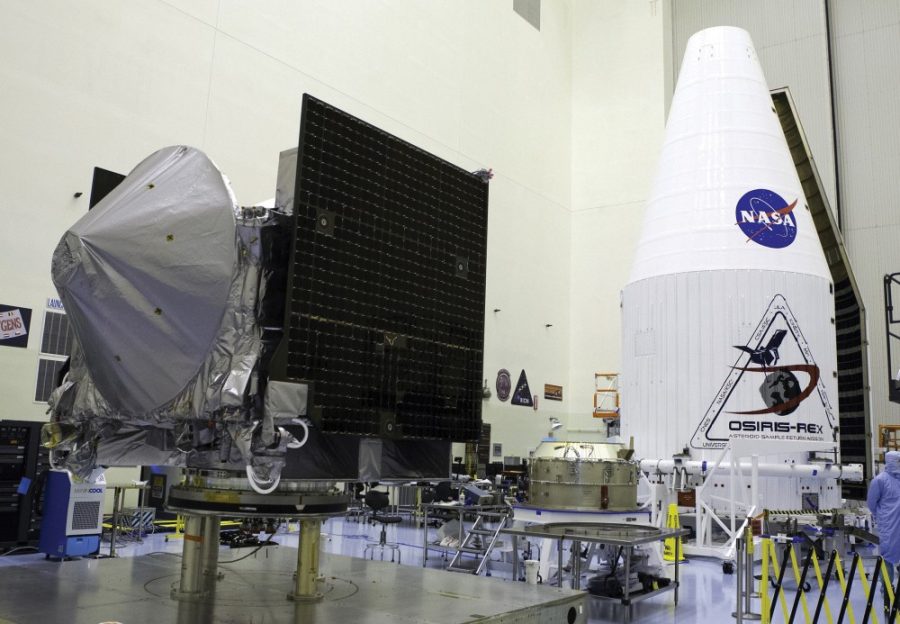Of all the scientific advancements and achievements born from the UA, few projects are as high profile as the ongoing OSIRIS-REx asteroid sample recovery mission. Here is a briefing on progress so far, as well as the goals anticipated on being accomplished.
Less than a year ago on September 8th, 2016, the Origins, Spectral Interpretation, Resource Identification, Security, Regolith Explorer (OSIRIS-REx) launched from Cape Canaveral, Florida and began the first leg of its journey towards the primitive asteroid, Bennu.
Bennu, selected from thousands of other near-Earth asteroids due to its size and extremely close orbit to our planet, is a carbonaceous asteroid.
“This means that it chemically has the potential to be the kind of stuff that could have landed on Earth later and brought in organic material,” said Renu Malhotra, a regents professor at the Lunar and Planetary Laboratory.
By using the spacecraft to retrieve a sample from the surface of Bennu, UA scientists hope to discover crucial information about the early formation of our solar system, and perhaps even the origins of life on Earth.
RELATED: Commencement speaker, former NASA head Charles Bolden talks space and education
Currently, OSIRIS-REx is cruising in orbit around the sun at a distance similar to that of Earth. But in just a few short months come September, the next leg of the OSIRIS-REx’s journey begins.
Roughly one year after its ascension into space, OSIRIS-REx will swoop back into close Earth orbit, where it will perform a flyby of the planet.
“OSIRIS-REx is going to have a slingshot maneuver with the Earth, change its orbital plane and then meet up with the asteroid in September of 920180,” Malhotra explained. “It’s called EGA: Earth Gravity Assist maneuver.”
By leveraging the Earth’s gravity to increase its speed, the team can save on fuel that can otherwise be used to readjust OSIRIS-REx’s orbital plane, as well as accelerate the spacecraft into Bennu’s orbit. As it gets closer to its destination, OSIRIS-REx will use its onboard thrusters in conjunction with a series of braking maneuvers to slow its approach near the asteroid.
By October 2018, the spacecraft will be in position to begin a survey of Bennu that will last for over a year. The primary purpose of the survey will be to locate an ideal site for the sample extraction phase of the mission. At which point, the true test of OSIRIS-REx’s engineering will begin.
RELATED: Wildcat science: A year in review
The spacecraft will attempt to extract a sample from the surface of Bennu without ever actually landing on it. OSIRIS-REx will float just close enough to the asteroid that it will be able to extend an articulated arm, created for gathering samples, called the Touch-And-Go Sample Acquisition Mechanism (TAGSAM).
“So after the scanning is done and it’s figured out what the best location is to get the sample from, the subsequent steps will be setup from the ground and then [up]loaded to the spacecraft,” said Malhotra.
At that point, the team will have three attempts to successfully extract a surface sample. If the first attempt happens to fail, the team must then use data from the spacecraft’s onboard instruments to adjust their calculations and make another attempt.
“Like any explorer that goes to uncharted country, the first thing you do when you go … is you make a map,” said Ed Beshore, deputy principal invesigator of Osiris-REx until his retirement in October 2016, in an October 2016 interview with the Daily Wildcat. “And so we’re going to be mapping the asteroid very carefully, not only to prepare ourselves for finding that sample but to be able to study those maps later on and say, ‘OK, we think we know with the sample on hand what we are seeing here.’”
Once the sample is finally collected, the orbital window for departing Bennu and returning to Earth will open in March 2021. At that time, OSIRIS-REx will activate its main engines and leave Bennu with a trajectory that will intersect with Earth’s orbit in September 2023.
Just before the spacecraft reaches Earth’s atmosphere, OSIRIS-REx will jettison the collected sample in a specialized return capsule that will free-fall towards Earth until roughly two miles above the deserts of Utah. At that point, it will deploy a parachute, landing safely to be collected for analysis, concluding the spacecraft’s seven-year odyssey.
However, the bulk of OSIRIS-REx will not re-enter Earth. Instead, the craft will attempt to deflect its approach trajectory and place itself into a stable orbit around the sun, at which point it will spend the rest of existence floating alone through the vacuum of space, a testament to mankind’s willpower to explore the stars.
Or perhaps simply a testament to mankind’s ability to leave our stuff everywhere.
For a complete breakdown of the OSIRIS-REx mission as well as a countdown timer to the slingshot maneuver, visit the official OSIRIS-REx website.
Follow Owen Zerambo on Twitter.









